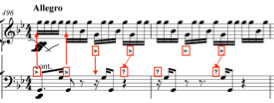Cuckoo passage, or making it swing on paper
(V3dT3)
The famous Cuckoo section in Vivaldi’s Summer concerto is based on the interplay of accents between the soloist and the continuo. While the violin part consists of repeated sixteenth notes on the upper string, with the 'cuckoo' accents on the lower string (reminiscent of the 'sword fighting' sixteenth note passages in Windmills V1b), the continuo supplements this passage with a repeated dotted figure. Given the regular 4/4 structure, the agogic and expressive timing is here constructed through the interaction between the performers.

Ex. 1 Cuckoo pattern in Vivaldi bb. 31-32 (Vivaldi, 1725).
Rasmussen displaces the accents in both the violin and continuo parts in order to achieve more rhythmic variety. The interactive platform between violin and continuo instruments is lost and the conductor is the only reference to the general pulse.

Ex. 2 Cuckoo with displaced accents in Rasmussen’s Summer concerto bb. 496-497 (Rasmussen, 2014).
The rhythmic sophistication, enhanced by displaced accents, got paradoxically lost in performance. We simply focused on 'staying together'. The only way to make the rhythms come together was to ask a second cellist (in agreement with the composer) to simply play pizzicato quarter notes to indicate the pulse. Having solved the problem of 'being together', the Rasmussen version of the Cuckoo did finally manifest interesting musical shapes and colours. The increasing complexity of the displaced accents, in relation to the pulsations in the 2nd cello, thus contribute to an aurally convincing culmination.
But for a Gesturist, the kinaesthetic sensation in the body movements lacks the interactive build up. Paradoxically, Vivaldi’s simple and repetitive structure affords a more palpable gestural culmination, where the simple patterns of impulses and relaxations are realized in an intensifying interplay between the performers’ body movements. The complexity of the structure in Rasmussen’s version did not lead to the expected increased activity in body movement.
Vid. 1 Comparison of the Cuckoo passage. The influence of Rasmussen’s complexity on expressive body movements.